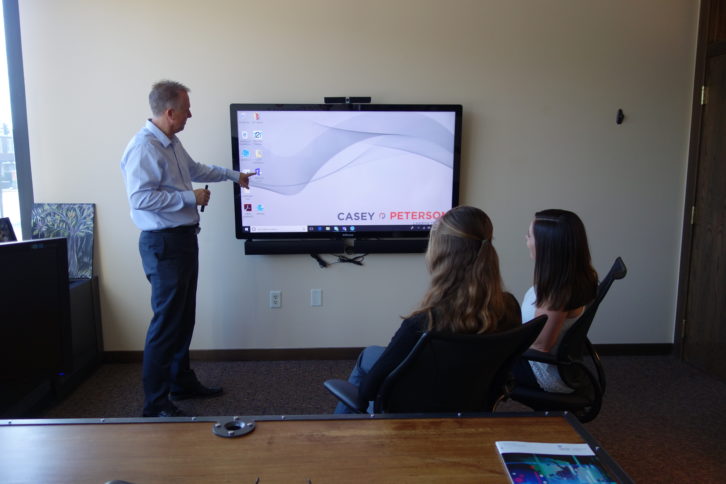
Making the right purchasing decision today will ensure the longevity of a solution. Ian McMurray asks the industry for its advice.
In a press release issued at the end of January, Synergy Research said that the market for video conferencing and collaboration will grow to well over $6 billion in 2019. (Gartner forecasts $7.1 billion by 2022.) However, that statistic masks a fundamental shift in the industry: the same company reports that what it calls ‘USB rooms’ now represent over 20% of all video rooms, up from less than 5% in 2016. Conversely, single codec rooms – those associated with ‘traditional’ videoconferencing – now represent just over 70% of the installed base, down from well over 90% in 2016.
‘USB rooms’ are, to all intents and purposes, what we’ve come to know as ‘huddle rooms’ (although the alternative name may be significant…). It will come as no surprise to anyone to hear that their apparently meteoric rise seems to continue unabated – although it should be said that Synergy Research is clear that, not only do videoconferencing suites still comprise the majority of installations, but also that their number continues to grow.
“Over the next five years, we anticipate this trend to continue, and for the decline in traditional single codec rooms to accelerate as users opt for more affordable and easily scalable USB solutions,” says Anne Marie Ginn, head of video collaboration, EMEA at Logitech Video Collaboration.
Surprising statistic
But Andrew Hug, vice president of sales and marketing at Polycom, has a surprising statistic.
“According to Research and Markets, there are 32 million huddle rooms globally,” he shares. “However, only 2% of these spaces include equipment for videoconferencing. In rooms not equipped with videoconferencing, this means huddling around a laptop or smartphone and struggling to fit more than one or two people on the screen. So many video conference solutions today are frustrating DIY experiences that result in poor audio and video that don’t allow teams to see and hear everyone clearly.”
“We expect the number of AV-enabled huddle rooms to increase by 15% in the next 12-24 months,” he continues, “and we’re already seeing great demand for Polycom Studio that supports this future trend.”
That electronically-enabled face-to-face communication and collaboration are the future is, of course, unquestioned. But that future is, perhaps, changing at an accelerating rate – so what does that mean for those installing collaboration systems today? It’s an increasingly important question to answer, given that facilitating collaboration has become a strategic imperative for many organisations.
“Videoconferencing and collaboration solutions are long-term investments,” believes Michael Helmbrecht, CPO/COO of Lifesize. “As such, organisations want to know their investments will continue to be supported and able to meet the needs of their business for years to come. Often, organisations that invest in the lowest-cost solutions are left with buyer’s remorse in 2-3 years when the equipment they’ve procured is obsolete, or the vendor that supplied it no longer offers support.”
Long lifecycles
“The most successful organisations are investing in technologies with long lifecycles knowing that, over time, they will incrementally add to the network to improve processes and productivity,” he continues.
But what are those “technologies with long lifecycles”? First and foremost the industry, pretty much to a man/woman, sees the cloud as being of fundamental importance when it comes to protecting those investments over the long haul.

“The cloud allows your communications services to be provided as a service, rather than a stand-alone piece of software that can eventually fall out of date,” according to Bradlee Allen, product evangelist at Fuze. “This not only helps future-proof your collaboration approach, but also means that they can be continuously updated and scaled to match your needs.”
“While many enterprises currently use on-premises products, today, businesses wanting to deploy a comprehensive collaboration platform are looking to implement cloud-based solutions,” says Kevin Bernitz, VP product management at StarLeaf. ”Cloud-based collaboration platforms will make it much easier to bring new services and functionality into their collaboration ecosystem. The cloud offers the freedom to upgrade functionality and deploy innovation almost instantly.”
Irrefutable
Of course, given the nature of their business, when it comes to Fuze and Starleaf backing cloud-based systems, there is an element of ‘Well, they would say that, wouldn’t they?’ – but the logic seems irrefutable. And, of course, collaboration is far from the only business application that has benefited from the cloud.
And: it’s not just them.
“Outdated, embedded technologies can be resistant to future-proof solutions such as cloud-based applications with USB end-points,” says Ginn. “Companies have woken up to the affordability and simplicity of plug-and-play systems paired with cloud-based UC software.”
Beyond that, Bernitz notes that, according to Gartner, the core growth driver in collaboration is cloud conferencing, with a compound annual growth rate of 5% through 2022.
So it seems that any organisation planning for its long-term collaboration strategy should, first and foremost, be seriously considering a cloud-based solution. What else?
Unsurprisingly, interoperability is very high on the list.
“We expect there will be a significant move towards interoperability as organisations start to demand that providers ‘play nicely together’,” says Bernitz. “Once this happens, businesses can derive more value from investments without dedicating the time and money to install separate systems.”
Loren Shaw, VP of marketing at InFocus, sees things a similar way. “Customers should be wary of hardware that locks them into a single platform, as it can limit available features and stifle ROI,” he believes. “Interoperability gives customers the option to choose the specific solutions that work best for their business.”
Of course, there are plenty of organisations out there that invested in collaboration systems many years ago – and may well have learned the hard way.
“Many organisations will have a mixture of legacy systems, different collaboration tools, and meeting room systems across their global network,” says Bernitz. “This means that the utopia of moving directly to a single platform can be difficult to achieve, even with the best intentions. Only with the help of a solution that provides a wide range of interoperability would this goal be achieved.”
Compatibility
A synonym for interoperability is, perhaps, compatibility – and, according to Polycom’s Hug, his parent company’s design philosophy delivers on that requirement.
“Having a one-stop shop for all collaboration needs brings comfort in knowing that all of the equipment and solutions are compatible, but for the optimum collaboration experience, it can be ideal to bring together hardware and software that is compatible with other collaboration platforms,” he says. “For example, if you are a Zoom user but someone outside of your organisation sets up a Microsoft Teams meeting, you want to be able to join that call just as easily as if you were using the meeting tool that your company has chosen.”
“That’s why,” he continues, “at Plantronics, our headsets and solutions easily integrate conferencing solutions like Zoom, Microsoft Teams, Microsoft Skype for Business, Cisco Webex and Amazon Chime, making any collaboration experience smooth, easy and highly productive.”
So cloud-based is important, and interoperability no less so. High on the list in Ginn’s mind is to ensure selection of the latest technology – but also to ensure that a solution that can hugely and positively impact both productivity and employee morale is easy enough to use that those who should benefit from it embrace it rather than shun it.
Next generation
“When selecting a solution, buyers should consider products that already include next generation technologies,” she asserts. “4K optics will soon be the standard, and artificial intelligence is helping to make the in-call experience smoother than ever. Most importantly, however, users should opt for a solution that is accessible and has minimal barriers to initiating a call, to ensure that the product is used to its full potential throughout its life cycle.”
“We fully expect 4K-quality videoconferencing to become the industry standard in the next five years,” echoes Helmbrecht. “The declining cost of bandwidth and rapid adoption of 4K displays will serve as significant tailwinds that drive 4K video conferencing across a variety of verticals.”
InFocus’s Shaw is of a similar mindset to Ginn when it comes to interoperability, compatibility and ease of use.
“Businesses should consider how a piece of equipment will provide long-term value,” he says. “For example, systems or devices compatible with only one conferencing platform can be limiting in the future if that platform is discontinued or no longer available, or if employees have trouble using it. Hardware with limited connectivity and compatibility options could negatively affect upgrades and expansion. Ideally, all conference systems from room to room should be identical for ease of use, and if only one space is being upgraded today, that equipment should be selected so that its next generation or a similar device can be implemented in other rooms in the future.”
Remote working
Cloud-based, interoperable/compatible and easy to use should, then, be top of mind in choosing a collaboration system that will deliver optimum ROI. There is one further key consideration: how easily does the solution accommodate remote working?
According to Polycom, currently, nearly 67% of the global workforce takes advantage of ‘anywhere working’. Back in May 2012, only 14% benefited from remote working. That’s a huge change in a short time – and one that is only likely to accelerate.
“For remote participants, it’s vital that joining a meeting is as simple and intuitive as possible,” says Helmbrecht. “For too long, videoconferencing solutions have relied upon pre-scheduled appointments that aren’t overly compatible with the mobile or remote user. In addition to traditional, pre-scheduled meetings, any Lifesize user can be reached via a unique video address or by joining a meeting in progress.”
“Face-to-face interaction is important for team building,” believes Shaw, “and gives remote employees a stronger presence in a large meeting – where on a phone system, they would be out-of-sight. For businesses with remote employees, selecting a conferencing platform that’s easy-to-use on laptops or mobile devices can help smooth the onboarding process.”
Ecosystem
Fuze’s Allen sees clearly that video is only one element in the ideal collaboration system.
“In addition to face-to-face interaction, businesses also need to provide tools that account for all different working styles,” he says. “For many, this will mean going beyond just video to create an entirely collaborative ecosystem that enables workers to communicate effectively — whether that’s live chat, file sharing, or a quick phone call. What’s more, if businesses can provide these services all within a single platform, this will accelerate and enrich the collaboration experience and make it much easier for workers to do their jobs effectively, regardless of individual working styles.”
Earlier, Hug raised the somewhat thorny question of the ‘one-stop shop’. Shopping around for individual ‘best-in-breed’ products and then, in effect, self-assembling them is superficially attractive. On the whole, however, the industry is against it – although Logitech believes it has established an appropriate compromise.
“Complete, codec-based systems may appear to be a simple one-stop solution, but they usually come with the drawback of being locked into a proprietary system that requires ongoing maintenance and subscription costs,” says Ginn. “To challenge this model, Logitech has taken advantage of the strength of our partnerships with world-class collaboration platform providers to develop complete collaboration system bundles. Consisting of the very best components from each class, these bundles help to create a solution that is better than the sum of its parts, and surpasses the abilities that any single system can offer.”
Integrator value
“Solution bundles are also only available through our authorised reseller network,” she adds, “which allows customers to take full advantage of the consultation that our partners can offer, advising on the best bundle for the type of room being equipped.”
She makes an important point: in a plug-and-play, anyone-can-do-it world, it’s too easy to overlook the value that a system integrator brings.
Lifesize’s Helmbrecht believes that single-sourcing a system can have at least one significant advantage.
“We’re able to stand behind the end-to-end experience and provide support to customers – regardless of whether they need assistance with one of our appliances, our applications, or our cloud service,” he says. “When you need support, your focus should be on resolving the issue, not chasing multiple vendors trying to triangulate what caused the problem.”
It’s tempting to believe that, with the inexorable rise of the huddle room and new, less-structured ways of working, videoconferencing is dead. That, however, is not what the industry is saying. In the minds of many, it is being redefined: what, after all, is a group of people sitting in a small room interacting visually and audibly with another group of people sitting in a small room, if it’s not videoconferencing? And, in fairness, the majority believe that the old style, dedicated videoconferencing suite still has a place for more formal meetings.
Clunky
“Videoconferencing is no longer limited to large meetings and conference spaces,” says Shaw. “Videoconferencing as we knew it may be dead – if you’re referring to platforms that are clunky, hard to connect, challenging to invite people to, with poor audio and video quality.”
“But videoconferencing as we imagine it in science fiction is coming to our offices,” he goes on, “where users can simply press a button to work on a document simultaneously, ‘hail’ a colleague for a quick chat, build relationships with customers around the world with face-to-face interaction, and more.”
Ginn chooses to use a similar adjective. “It’s the expensive, clunky, single codec legacy systems of old that are dying,” she echoes. “Companies have woken up to the affordability and simplicity of plug-and-play systems paired with cloud-based UC software – and the days of single codec video calling are limited.”
StarLeaf’s Bernitz summarises the situation perfectly.
“Videoconferencing is thriving and ubiquitous,” he avers. “Enterprise-grade videoconferencing that was once only reserved for the most highly paid employees in the largest boardrooms is now accessible to anyone at any size of company.”
For many organisations, collaboration has become strategic because it is the preferred style of working – not least because it reflects the preferences of an increasingly millennial-dominated workforce. As such, it’s vital to take a long-term view that will ensure the extended validity and viability of the chosen solution – maximising RoI. Increasingly, it seems, the collaboration industry is facilitating the making of good purchasing decisions.







